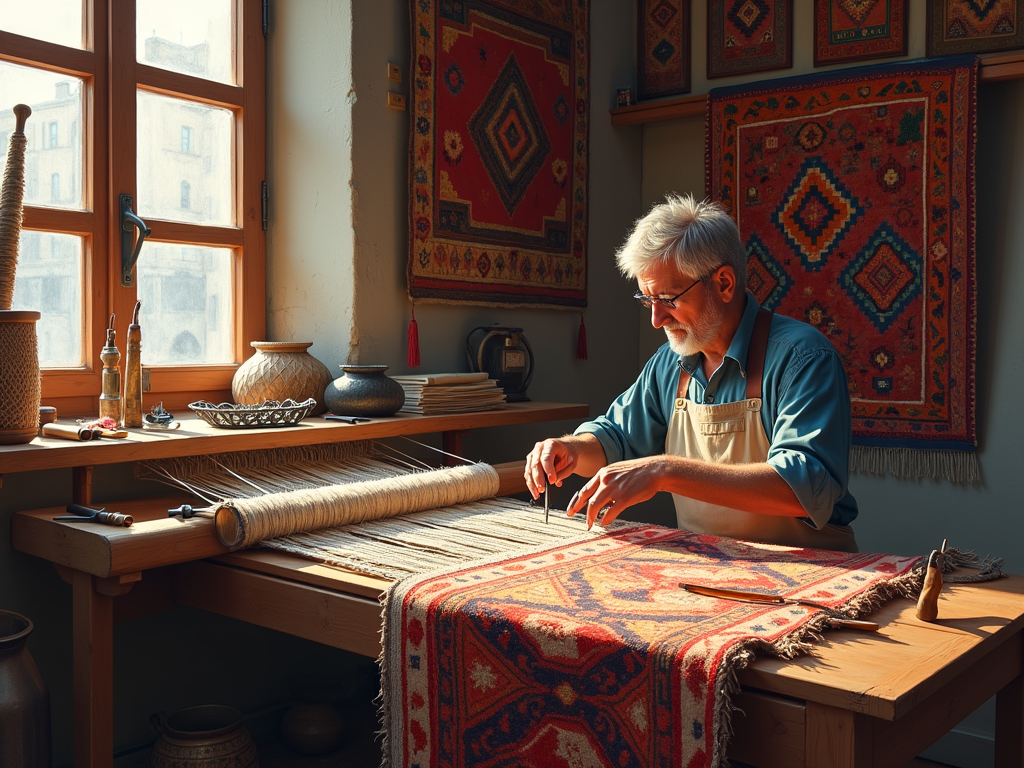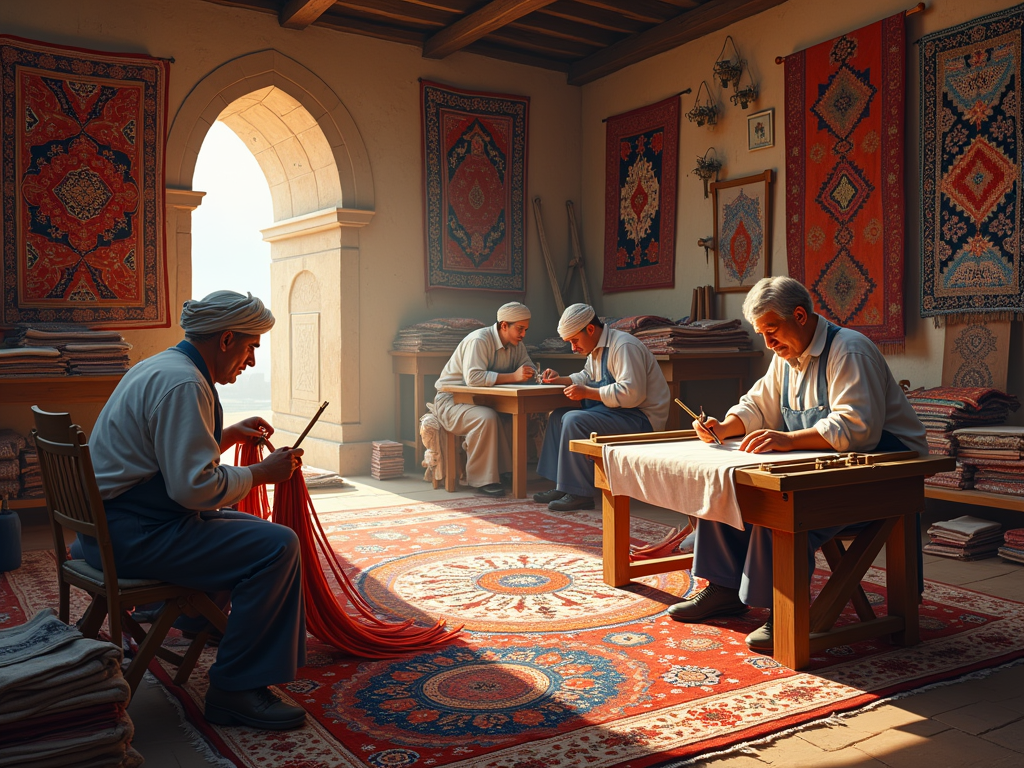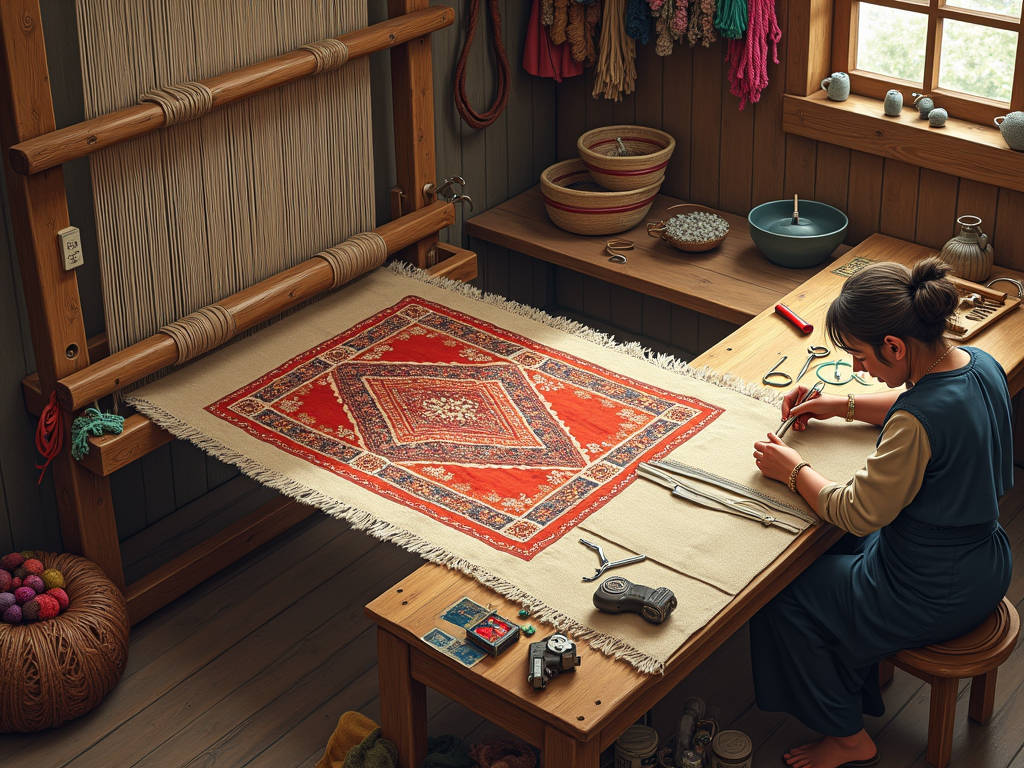
Professional Titles of Rug Creators
Professional rug creators carry distinct titles that reflect their skills, methods, and cultural backgrounds. This traditional craft includes specialized roles like rug weavers, rug hookers, and carpet artisans, each mastering specific techniques passed down through generations. The field has transformed to include modern titles such as textile artists and fiber artists, showcasing its artistic evolution.
Key Takeaways
- Different specialized titles exist based on technique, including rug weavers, rug hookers, rug braiders, rug tufters, and carpet knotters.
- Cultural traditions influence titles, with terms like “ostad” in Persian culture and “halı dokumacısı” in Turkish traditions.
- Modern professionals may be called textile artists, fiber artists, or floor covering specialists depending on their focus.
- Prayer rug makers carry distinct titles reflecting their religious and cultural significance.
- Contemporary rug makers often combine multiple techniques, leading to broader professional designations.
Understanding Different Rug Maker Titles
Each title highlights unique aspects of the craft. A rug weaver focuses on creating intricate patterns through traditional loom work, while a rug hooker specializes in pulling loops of fabric through a backing material. Carpet knotters dedicate their expertise to the precise art of hand-knotting. These specialized roles preserve the authenticity and quality of rug making across different cultural contexts and time periods.
The Many Names of Professional Rug Makers
Professional rug making has deep cultural significance, with practitioners carrying different titles based on their specialized techniques. The ancient craft of rug making originated thousands of years ago, leading to various specialized terms for those who create these beautiful floor coverings.
Traditional Titles and Specializations
‘Rug maker’ stands as the most common term, serving as a catch-all description for anyone who creates rugs professionally. The time-honored tradition of rug making has spawned several specific titles that reflect distinct techniques:
- Rug weavers focus on creating rugs using looms and intricate weaving patterns
- Rug hookers specialize in pulling loops of fabric through a stiff backing material
- Rug braiders create rugs by interweaving strips of fabric into complex patterns
- Rug tufters use specialized tools to push yarn through backing material
- Carpet knotters tie individual knots to create detailed designs
Modern Professional Classifications
The contemporary rug-making industry has brought new terminology to describe these skilled craftspeople. Different cultural traditions have influenced how we refer to rug makers today. Textile artist has become a popular term, particularly in fine art circles, highlighting the creative aspects of rug making. Rug artisan emphasizes the handcrafted nature of the work, while fiber artist encompasses those who work with various textile materials.
Many rug makers specialize in specific styles or techniques. Persian rug artisans master intricate knotting techniques passed down through generations. Some focus on contemporary machine-aided production, earning titles like carpet technician or machine operator.
The role of religious and cultural traditions can’t be overlooked in rug-making terminology. Islamic cultural influence has given rise to specific terms for prayer rug makers, who create pieces with particular religious significance. These specialized craftspeople often carry titles that reflect their sacred work, such as prayer carpet weaver or Islamic textile artist.
Modern rug makers might combine multiple techniques, leading to broader professional titles like textile designer or floor covering specialist. These terms reflect the growing complexity of the craft and its integration with interior design and home décor industries. The title chosen often depends on the market they serve, their specific expertise, and the traditions they follow in their craft.

Mastering Traditional Rug Making Techniques
Hand-Knotting: The Crown Jewel of Rug Making
As a master rug maker, I can tell you that hand-knotting stands as the most respected technique in traditional rug making history. This intricate process centers on two primary knot styles: the Persian (Senneh) and Turkish (Ghiordes) knots. Each knot type creates distinct patterns and textures, with skilled artisans in renowned rug-making regions tying between 100 to 400+ knots per square inch.
Alternative Rug Making Methods
Hand-weaving produces beautiful flatweave rugs that have become increasingly popular in modern homes. The ancient craft of kilim making creates durable, reversible rugs perfect for high-traffic areas. Dhurries and soumaks follow similar principles but offer unique cultural and artistic expressions.
Here’s what makes each technique special:
- Hand-tufting uses specialized tools to push yarn through a backing fabric, creating pile rugs faster than traditional knotting
- Needle felting relies on barbed needles to interlock wool fibers, producing dense, durable rugs
- Flatweave techniques create distinctive patterns without pile, ideal for lighter-weight rugs
- Traditional prayer rug making combines various techniques for specific cultural and religious purposes
The artisans who practice these methods are called by different names depending on their specialization and region. A hand-knotter might be known as a rug weaver or carpet maker, while those who specialize in needle felting are often called felt artists or textile artists. Many modern rug makers combine multiple techniques to create innovative designs while honoring traditional methods.
Cultural Heritage and Regional Expertise
The art of rug making carries deep cultural significance across different societies, with master craftspeople holding respected positions in their communities. Traditional rug making origins shape the titles given to these skilled artisans.
Master Craftspeople Across Cultures
In Persian traditions, master rug makers are known as “ostad” – a title that reflects years of dedication to perfecting their craft. These skilled artisans often start learning their trade as young apprentices, spending decades mastering the intricate patterns and techniques that make Persian rugs distinct from other varieties.
The rich heritage of rug making extends beyond Persia. In Navajo culture, master weavers are called “Master Weaver” or “Na’alvéhí” in their native language. These artisans are celebrated for their ability to create intricate designs that tell stories and preserve their cultural heritage. Their work is particularly significant as rugs hold special meaning in various cultures.
Here’s how different cultures recognize their rug-making experts:
- Turkish culture refers to their master rug makers as “halı dokumacısı“.
- Moroccan rug artisans are known as “nassaj” or “hiyaka“.
- Scandinavian Rya rug makers carry the title “mattovävare” in Swedish regions.
- Indian carpet weavers earn the respected title of “kaleen bunakar“.
In modern times, professional rug makers might also be called carpet artisans, textile artists, or fiber artists, depending on their specific focus and region. Different regions are famous for their unique rug-making traditions, with master craftspeople often specializing in specific styles or techniques particular to their cultural heritage.
The path to becoming a master rug maker varies by culture, but it typically involves years of apprenticeship under experienced craftspeople. In many traditional societies, rug making techniques and knowledge pass from generation to generation, with each family developing its own signature patterns and methods.
Tools and Methods of the Trade
Traditional Weaving Equipment
I can tell you that rug making starts with the fundamental relationship between warp and weft threads. The warp threads stay fixed in place while the craftsperson carefully passes weft threads through them to create the base structure. This forms the backbone of traditional rug weaving techniques that date back centuries.
Traditional looms stand as essential equipment for any serious rug maker. These frames hold the warp threads tight, letting artisans work efficiently while maintaining consistent tension. The setup might look simple, but it’s this basic framework that allows master weavers to create intricate patterns that have made certain regions famous for their rugs.
Modern Tools and Techniques
The tufting gun has changed the game in modern rug production. This tool punches yarn through a backing material to create pile rugs quickly and effectively. While machine tufting speeds up production and reduces costs, hand-tufted rugs made by skilled artisans command higher prices due to their craftsmanship and attention to detail.
Hooking techniques need specific materials to succeed. The choice of backing material makes a big difference – burlap and linen are popular picks because they’re sturdy enough to hold up during the making process but still flexible enough to work with easily. These materials give different styles of rugs their unique characteristics, from casual area rugs to formal pieces.
Here’s what you’ll typically find in a rug maker’s toolkit:
- Tufting guns (manual or electric)
- Stretching frames for holding backing material
- Yarn scissors and thread snips
- Pattern templates or design maps
- Backing materials like burlap, linen, or cotton
- Various sizes of hooks and needles
- Yarn guides and threading tools
I’ve found that the art of rug making combines ancient wisdom with modern innovation. Whether using time-tested hand-weaving methods or contemporary tufting techniques, each approach needs its own set of specialized tools and materials. The choice between hand versus machine methods often depends on the desired outcome, budget constraints, and time available for production.

Modern Rug Making Professions
The art of making rugs has transformed significantly since its ancient origins in textile craft. I’ve found that today’s rug makers go by various professional titles depending on their specialization and work environment.
Professional Titles in Rug Making
A rug maker can be called a carpet weaver, textile artist, or rug designer based on their specific role. These skilled craftspeople carry forward the rich traditions from famous rug-making regions while adding contemporary twists to their work. Independent artists often identify as fiber artists or textile designers, creating custom pieces that blend traditional techniques with modern aesthetics.
Industry Roles and Specializations
The rug-making industry features several specialized roles:
- Hand-knotting specialists focus on creating intricate Persian and Oriental rugs
- Tufting technicians operate specialized machines for commercial production
- Pattern designers develop unique motifs and layouts
- Color specialists select and match yarn shades
- Production managers oversee large-scale manufacturing
- Textile engineers improve manufacturing processes
Many modern rug makers combine multiple skills, particularly in smaller studios. Independent artisans might handle everything from design to production, while larger manufacturers employ specialists for each step. The spiritual significance of rug making, especially in Islamic cultural traditions, continues to influence contemporary craftspeople.
I’ve noticed that digital technology has added new dimensions to the profession, with some rug makers using computer-aided design (CAD) software to create patterns. This blend of traditional craftsmanship and modern tools has expanded the definition of what it means to be a rug maker in today’s market.
Sources:
The Textile Atlas
Hali Magazine
Rug Insider Magazine
The Encyclopedia of Rugs & Carpets by Alastair Hull and Jose Luczyc-Wyhowska
